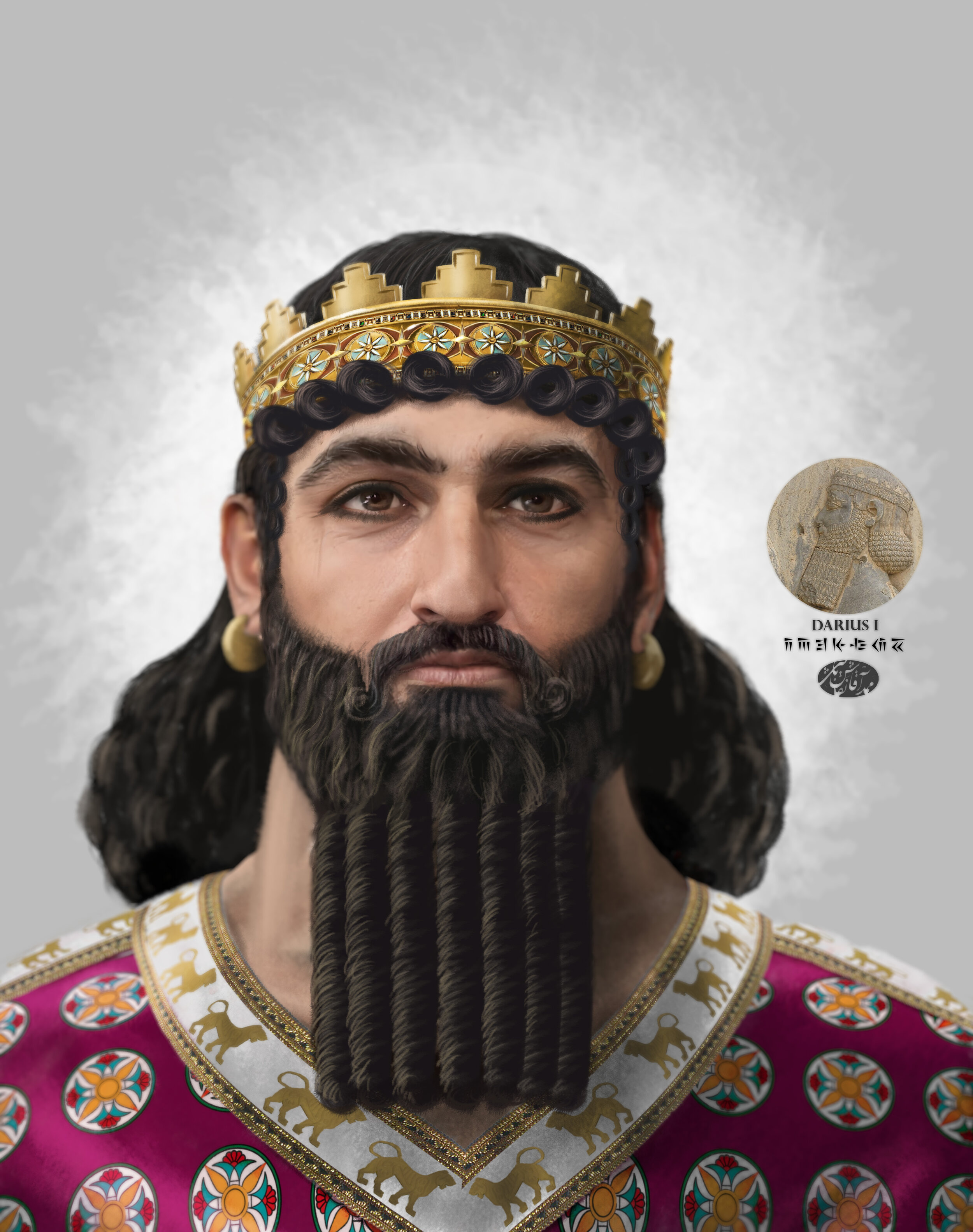Darius I
522 – 486 BCE
Darius the Great | Dārǝyāweš | Darəyaveš | داریوش بزرگ | داریوش | 𐎭𐎠𐎼𐎹𐎺𐎢𐏁
A likeness Darius the Great with a golden background. Download
Ver.1.0 - Last updated: Sep 22th 2021, by Mo. Rasoulipour
Brief Biography
“Darius the Great, was the third Persian King of Kings of the Achaemenid Empire, reigning from 522 BCE until his death in 486 BCE. He ruled the empire at its peak…”
“Darius organized the empire by dividing it into provinces and placing satraps to govern it. He organized Achaemenid coinage as a new uniform monetary system, along with making Aramaic the official language of the empire. He also put the empire in better standing by building roads and introducing standard weights and measures. Through these changes, the empire was centralized and unified. Darius also worked on construction projects throughout the empire, focusing on Susa, Pasargadae, Persepolis, Babylon, and Egypt. He had the cliff-face Behistun Inscription carved to record his conquests, an important testimony of the Old Persian language. “
- Excerpt from Wikipedia
Read more on the links below:
Name
“Dārīus (or Dārēus) is the common Latin form of Greek Dareîos, itself a shortened rendering of Old Persian five-syllable Dārayavauš (spelled d-a-r-y-v-u-š), the throne name of Darius the Great and two other kings of the Achaemenid dynasty, which thus enjoyed considerable popularity among noblemen in later periods (see vi-viii, below). The original Old Persian form was also reflected in Elamite Da-ri-(y)a-ma-u-iš, Babylonian Da-(a-)ri-ia-(a-)muš and so on, Aramaic dryhwš and archaizingdrywhwš, and perhaps the longer Greek form Dareiaîos…”
- Via Encyclopedia Iranica
References
The depiction of Darius in Behistun has been used as a primary source for this recreations. Although due to this works striking similarity, not only in style but in face, to it’s contemporary Assyrian reliefs, the image is more likely symbolic and stylized than realistic. Nevertheless it is perhaps the clearest depiction of him that currently exists. There is also an image on a vase found in the Italian peninsula dated to a few centuries after that Darius’s death dubbed the “Darius Vase“ some believe is of him. That particular work is not used as a reference due to the following reasons: Not being his contemporary, doubts about the identity of the pictured figure, clear and heavy Hellenistic influence and likely inaccuracies in clothing and crown.
The colors and patterns used for this recreation are referenced in the Iranica Online article on Achaemenid clothing ii which describes the official clothing customs and the symbolic value of the colors at the time. Although there is no specific mention of what Darius I wore officially, the picture above shows detailed drawings of studies done on the son of Darius I, Xerxes I’s figure in Persepolis. The patterns display circular symbols placed neatly in a square grid, with the edges of the clothing lined with margins of lions lined up facing one direction. According to the studies done on Behistun and Darius’s Tomb, there were no traces of color found on clothing other than a deep red color on the shoes, so we can not be certain as to what color Darius’s court dress might have been. (Alexander Nagel, Oxford Handbook of Ancient Iran, Color and Guilding in Achaemenid Architecture and Sculpture, Page 603)
There seem to be reports from Greek writers pointing to Purple robes for Achaemenids and Medes (See Iranica Online article on Achaemenid clothing ii). The dominant narrative of Purple robes seems to be at odds with the color findings in Persepolis, though there is a chance that there was a common color that they both point to being deep red or crimson.
Likely Accuracy of the Creative Construction
Wild - Weak Guess:
Although there is a narrative that supports colors and a very clear image of what the crown could have looked like in Behisun, the face, as discussed above is likely very idealistic and stylized and therefore could not give us a good image of what Darius I could have exactly looked like. Therefore this recreation of Darius would be considered a Wild to a Weak Guess.
See the latest work in progress:
Permissions
This is as close as a creative project can get to being open source. You are welcome to download, use, and modify the images.
You are however not permitted to sell the products or place barriers of access for public view and use.
See any issues with this page? Want to say hi to the creator of this page? Reach them via the link below:
Are you a content creator?
If you are a content creator and would like access to the working files please sign up here. We’d love to connect with you and help promote your work.









